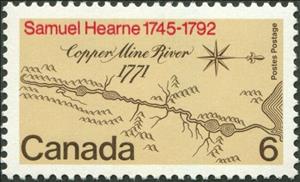Stamp: Bicent. of Samuel Hearne's Expedition to Coppermine River (Canada 1971)
Bicent. of Samuel Hearne's Expedition to Coppermine River (Canada 1971)
07 May (Canada ) within release Bicent. of Samuel Hearne's Expedition to Coppermine River goes into circulation Stamp Bicent. of Samuel Hearne's Expedition to Coppermine River face value 6 Canadian cent
| Stamp Bicent. of Samuel Hearne's Expedition to Coppermine River in catalogues | |
|---|---|
| Stamp Number: | Sn: CA 540i |
Stamp is horizontal format.
Chart of Coppemine River. ghost print, red doubled on Samuel Hearne 1745-1792.Stamp Bicent. of Samuel Hearne's Expedition to Coppermine River it reflects the thematic directions:
An anniversary is the date on which an event took place or an institution was founded in a previous year, and may also refer to the commemoration or celebration of that event. For example, the first event is the initial occurrence or, if planned, the inaugural of the event. One year later would be the first anniversary of that event. The word was first used for Catholic feasts to commemorate saints. Most countries celebrate national anniversaries, typically called national days. These could be the date of independence of the nation or the adoption of a new constitution or form of government. The important dates in a sitting monarch's reign may also be commemorated, an event often referred to as a "Jubilee".
An exposition, in the most general sense, is an organized presentation and display of a selection of items. In practice, exhibitions usually occur within museums, galleries and exhibition halls, and World's fairs. Exhibitions can include many things such as art in both major museums and smaller galleries, interpretive exhibitions, natural history museums and history museums, and also varieties such as more commercially focused exhibitions and trade fairs.
A map is a symbolic depiction emphasizing relationships between elements of some space, such as objects, regions, or themes. Many maps are static, fixed to paper or some other durable medium, while others are dynamic or interactive. Although most commonly used to depict geography, maps may represent any space, real or imagined, without regard to context or scale, such as in brain mapping, DNA mapping, or computer network topology mapping. The space being mapped may be two dimensional, such as the surface of the earth, three dimensional, such as the interior of the earth, or even more abstract spaces of any dimension, such as arise in modeling phenomena having many independent variables. Although the earliest maps known are of the heavens, geographic maps of territory have a very long tradition and exist from ancient times. The word "map" comes from the medieval Latin Mappa mundi, wherein mappa meant napkin or cloth and mundi the world. Thus, "map" became the shortened term referring to a two-dimensional representation of the surface of the world.



